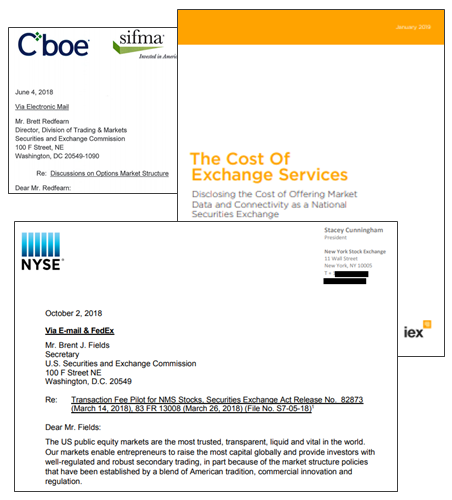
Table of Contents
When Regulation NMS (Reg NMS) came into effect in the mid-2000s, many benefits sprung to life immediately. For example, retail orders were provided protection, markets were made more interconnected, and decimalization was further codified under Rule 612. That said, at the time Reg NMS was adopted, many commenters worried about liquidity aggregation in a penny and sub-penny (for orders under a dollar) environment, and that concern has only grown. Over time, the markets have continued to evolve and change, although Rule 612 has remained essentially stagnant.
Nasdaq's Tick Size Proposal
Nasdaq has previously published two pieces with their analysis for proposed U.S. equity market reforms, 2017’s Revitalize and 2019’s TotalMarkets. Both papers offer sweeping suggestions for market structure reform and beyond. Nasdaq’s efforts, among many other market participants, have garnered much debate and analysis, but have resulted in few significant changes to our market structure.
Perhaps with that in mind, Nasdaq has published a new paper, Intelligent Ticks. In Intelligent Ticks, Nasdaq narrowly focuses on the issue of tick size in the U.S. equity market with the stated desire of moving the market forward on this debate. Their view and analysis is that our current “one-size-fits-all” tick regime is no longer effective for the marketplace.
Nasdaq’s primary arguments for tick size change are:
- Low priced stocks are often “tick constrained”, meaning the quote is nearly always at the minimum penny spread. As such, a lower tick might allow improvements in queues, fulfillment rates, and price discovery.
- High priced stocks also have the same penny-wide tick. With high prices often come wider spreads. In such securities, a small required tick size allows for the possibility of flickering quotes, increased odd lot quoting and trading, queue jumping for economically insignificant amounts, and increased fragmentation of liquidity.
At its core, Nasdaq proposes the following changes:
- Ticks would be established at one of the following six increments: $0.005, $0.01, $0.02, $0.05, $0.10, and $0.25.
- Categorization of the stocks would be based on their average quoted spread over a measurement period.
- Stocks would only be placed in lower tiers (e.g., a stock with an average spread over the measurement period of $0.11 would be placed in the $0.10 bucket).
- Stocks would be evaluated on six-month periodic basis to determine the appropriate tick size bucket.
Beyond Ticks: Other Market Structure Proposals
While Nasdaq has been very active in the market structure reform debate, the other exchanges have also provided various outlooks on the current state of the markets.
NYSE submitted an alternative proposal for a simplified Transaction Fee Pilot in October of 2018, suggesting lowering access fees to $0.001 and establishing a moratorium on increases to existing market data products, connectivity fees and co-location fees. More recently, at least partially in response to the August 2019 CTA SIP outage, NYSE proposed that the SIPs be restructured in a three-tiered structure, comprised of Essential (basic), Classic (enhanced with auction and odd lot data) and Premium (which would also include some depth of book information). In its statement, NYSE noted that “one size does not fit all”1. NYSE has also actively been engaged in the market data debate, retaining an expert to review the overall cost of market data and its linkage to the overall trading platform of the exchanges. Along those lines, NYSE has submitted that report along with proposals to lower fees for display-only feeds and introduce new feeds for its NYSE National Integrated Feed market data product.
The options market has also been in focus. In June 2018, the Cboe joined with SIFMA and the STA to request the creation of an Exchange/Industry Working Group to review the current options market structure. The letter proposes that the working group address whether or not steps should be taken to update some of the unintended consequences of regulation in the options market, in particular since the adoption of Reg NMS. The option market’s role in US equities should not be underestimated, and will only continue to grow moving forward.
Of course, the other incumbent exchanges have not been silent during this time. IEX has raised the stakes in the debate over cost of market data with its paper outlining its costs of market data and connectivity and yesterday announced its proposal to extend its Crumbling Quote Indicator feature to displayed and non-displayed orders as "D-Limit" orders. MIAX has also thrown its hat in the ring with its equities exchange application filed with the SEC in August and a planned launch in Q2 2020.
When the Rubber Meets the Road
Nasdaq has provided significant data to support a view we have long held that a “one-size-fits-all” market structure is not optimal for investors. The increasing number of high-priced stocks, the decreasing amount of stock splits, the growing quantity of tick-constrained trading, as well the snowballing growth of odd lots all point towards the need for a change in the tick size regime.

As always, of course, the devil remains in the details:
- Are six tick size buckets the right number - or is it too many or too few? Any change to the current tick size regime will meet with resistance. However, the data presented by Nasdaq reasonably supports the proposed tick sizes.
- Should tick sizes for securities trading above a dollar be reduced to $0.005, or will this exacerbate issues of queue jumping in such stocks? The challenge for reducing ticks to $0.005 for stocks trading above a dollar will primarily result from an increase in queue jumping. Moreover, firms which internalize order flow will also find it more difficult to provide enhanced executions in a half-cent spread environment. As a result, execution statistics may actually worsen for this segment based on the current methodology for calculation.
- How much of a technological lift will be required of the market participants, and when will this be expected to be slotted into an already overcrowded regulatory work slate? Even though the market adjusted for the SEC’s Tick Size Pilot, there would still be considerable technological work for firms to be able to properly incorporate Nasdaq’s proposed tick size regime. As such, it is incumbent on the industry, regulators and exchanges to ensure that any such roll-out would be slotted into the regulatory calendar in such a way as to minimize the opportunity for exacerbating what is already seen as an excessive work burden. As always, the challenge is to find any time not already allotted for other mandated changes.
All of these questions, and many more, will be the focus of industry discussions as we move forward. In any event, whatever position you take on these matters, the exchanges should all be lauded for helping to take the discussion of market structure to the forefront, and Nasdaq in particular, for urging us all to take a closer look at whether or not a “one-size-fits-all” tick regime is still in tune with the market.
1While this quote is variously attributed, my favorite (and the inspiration for the title) has to be Frank Zappa.



